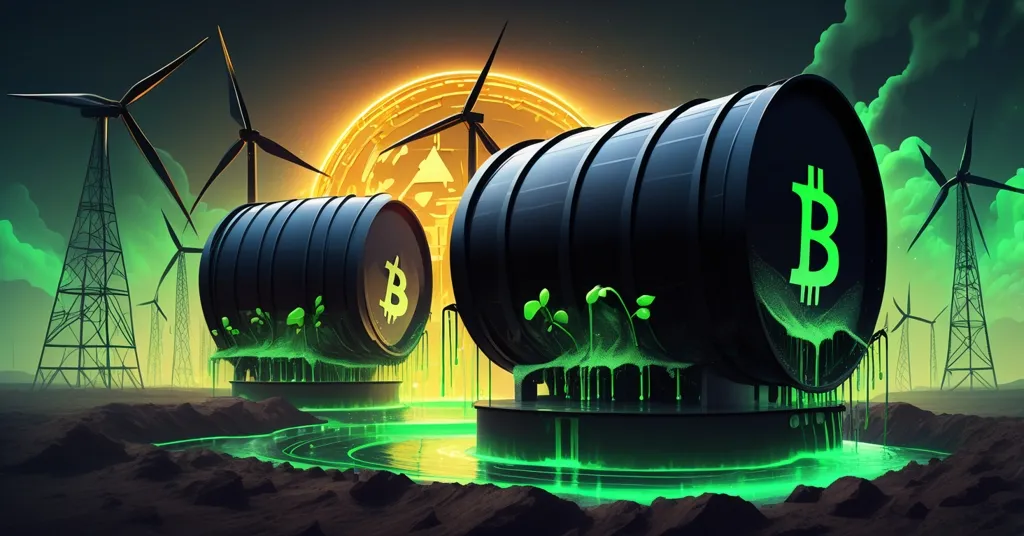IEA Predicts 2026 Oil Surplus: Bitcoin Mining Costs and Crypto Impacts Explored

IEA Forecasts Record Oil Surplus by 2026: Implications for Bitcoin and Energy Costs
The International Energy Agency (IEA) has issued a stark warning: a record-breaking oil surplus is on the horizon by 2026, potentially dwarfing even the stockpiles of the 2020 COVID-19 crisis. This oversupply, fueled by sluggish demand and relentless production, could reshape global energy markets—and it’s got unexpected ripple effects for Bitcoin, cryptocurrency mining, and the broader push for decentralization.
- Historic Surplus Looming: IEA predicts a 2.96 million barrel-per-day inventory build by 2026.
- Demand Slumps: Oil demand growth hits a low of 680,000 barrels per day in 2025.
- Crypto Impact: Cheaper oil could cut Bitcoin mining costs, but risks remain.
The Oil Oversupply Crisis Unpacked
The International Energy Agency’s latest report lays out a grim scenario for oil markets, projecting an inventory build-up of 2.96 million barrels per day by 2026. To put that in perspective, it’s a staggering excess—greater than the stockpiling rate during the 2020 pandemic when demand collapsed under global lockdowns. Back then, the largest quarterly surplus ever recorded hit over 7 million barrels per day in Q2. Today’s looming crisis isn’t a sudden shock but a slow-motion trainwreck of structural issues. Global oil demand growth is expected to crawl at just 680,000 barrels per day in 2025—the weakest since 2019—before inching up to 700,000 in 2026. Major consumers like China and India are faltering, unable to counterbalance broader trends toward efficiency and alternative fuels.
Meanwhile, supply is gushing like a fire hose on full blast. Non-OPEC+ producers—think the United States, Canada, Guyana, and Brazil—are set to pump an extra 1 million barrels per day in 2026, a bump of 100,000 from earlier estimates. On the other side, OPEC+ (a coalition of oil-producing nations led by Saudi Arabia and including Russia) is reinstating a previously paused cut of 2.2 million barrels per day by September 2025, with output hikes already underway. The United Arab Emirates just smashed its own record, producing 3.5 million barrels per day and blowing past its quota, further flooding the market. As a result, global oil inventories are already at their highest in nearly four years as of June 2025, and crude prices have tanked 12% this year, hovering around $66 per barrel for Brent crude (a key global benchmark for oil pricing). Analysts at Goldman Sachs even warn Brent could slip to $64 by late 2025 if this imbalance persists.
“Oil-market balances look ever more bloated,” the IEA cautions, adding, “It is clear that something will have to give for the market to balance.”
Why the demand drop-off? It’s not a mere blip but a tectonic shift. The IEA points to accelerating adoption of electric vehicles (EVs) and cleaner energy alternatives, forecasting that oil demand could plateau by the end of the decade. Geopolitical headwinds aren’t helping either. Fears of an economic slowdown, stoked by potential trade wars under President Donald Trump’s policies, are dampening consumption. Trump’s push for lower fuel prices might cheer drivers at the pump, but it’s spooking markets, with threatened tariffs on nations like India for buying Russian oil adding a layer of uncertainty. While sanctions on Russia or Iran could theoretically tighten supply and ease the glut, the current path is all about excess—enough to make even a crypto rug pull look tame by comparison.
Why Oil Markets Matter to the Crypto Space
Energy isn’t just about fueling cars or heating homes—it’s the lifeblood of Bitcoin’s decentralized revolution. Bitcoin mining, the process of validating transactions on the network, is notoriously power-hungry. Miners use specialized computers to solve complex mathematical puzzles through a mechanism called Proof-of-Work, consuming vast amounts of electricity in the process. A single Bitcoin transaction can use as much energy as an average U.S. household does in weeks. So when oil prices plummet, as they’re doing now, the cost of generating that electricity could drop in regions tied to oil-based energy grids, offering miners a potential lifeline on operational expenses.
But before we pop the champagne, let’s not forget the flip side. Energy markets are as volatile as a memecoin pump-and-dump, especially with geopolitical storms brewing. If Trump’s trade wars tank the global economy or sanctions choke off Russian or Iranian oil, sudden price spikes could hit miners where it hurts. Plus, the long-term shift away from fossil fuels toward renewables—part of what’s killing oil demand—puts Bitcoin under the microscope for its environmental impact. The crypto community isn’t just battling FUD (fear, uncertainty, doubt) from regulators; it’s facing ESG (Environmental, Social, Governance) pressures to clean up its act. Energy markets, in short, are a double-edged sword for decentralization’s flagship asset.
Bitcoin Mining: Energy Costs in Flux
Let’s dig into the nitty-gritty of mining economics. The cost to mine one Bitcoin varies wildly by region, largely due to electricity prices. In energy-rich areas like Texas, where oil and gas dominate, miners often pay as little as $0.03-$0.05 per kilowatt-hour, keeping costs per BTC around $20,000-$30,000 depending on hardware efficiency. Compare that to regions with pricier grids, where costs can balloon past $50,000 per coin. A surplus-driven drop in oil prices to $66 or even $64 per barrel could shave a few more cents off those rates in oil-dependent zones, boosting margins for miners already scraping by post-halving (when mining rewards are cut in half roughly every four years, as happened in 2024).
There’s a particularly interesting angle here for oil-rich regions dealing with oversupply: flared gas. This is natural gas that’s a byproduct of oil drilling, often burned off as waste because it’s uneconomical to store or transport. Miners in places like Texas and North Dakota have started using this otherwise wasted gas to power rigs, turning a liability into cheap, off-grid energy. With oil production ramping up, more flared gas becomes available, potentially amplifying this trend. Companies like Crusoe Energy are already capitalizing on this, cutting both costs and carbon footprints—a rare win-win.
But don’t bet the farm just yet. Geopolitical curveballs could flip the script overnight. If sanctions on Russia tighten or Trump’s tariffs spark retaliatory trade chaos, energy prices could spike, wiping out any surplus-driven savings. Mining hubs in volatile regions—or those tied to shaky grids—could face shutdowns or skyrocketing costs. Bitcoin’s resilience lies in its adaptability, though. Miners are increasingly relocating to renewable hotspots like Iceland or Canada, where hydropower offers stable, green energy. The oil glut might ease short-term pain, but it’s a reminder that energy volatility in mining is a beast miners must tame to keep the network humming.
Energy Transition: Threat or Opportunity for Bitcoin?
The same energy transition gut-punching oil demand—think EVs replacing gas-guzzlers and solar farms outpacing coal—casts a long shadow over Bitcoin. Mining’s carbon footprint has been a lightning rod for criticism, with estimates suggesting the network emits as much CO2 annually as a mid-sized country like Argentina. As oil demand flatlines by decade’s end, per the IEA, public and regulatory scrutiny on energy-intensive industries will only intensify. Bitcoin isn’t just fighting for adoption; it’s fighting for legitimacy in a world prioritizing sustainability.
Yet there’s a silver lining for those of us rooting for decentralization. Many miners are already pivoting to renewables—over 50% of Bitcoin’s mining energy reportedly comes from sustainable sources as of late 2025, per industry trackers like the Bitcoin Mining Council. Operations in Quebec tap cheap hydropower, while others harness geothermal energy in places like El Salvador, where Bitcoin is legal tender. An oil surplus might buy time with cheaper fossil fuel costs, but the real play is in green tech. If miners can fully decouple from dirty energy, Bitcoin could shed its eco-villain label and solidify its place as a future-proof asset.
Moreover, let’s not overlook Bitcoin’s core strength amid this energy upheaval. If Trump’s trade wars or economic policies trigger fiat devaluation fears—as they well might with a global slowdown—Bitcoin’s censorship-resistant, borderless nature shines brighter than ever. An oversupplied oil market could be the perfect storm for BTC to emerge as a hedge against the crumbling status quo, provided miners navigate the energy maze. It’s not just survival; it’s a chance to thrive.
Altcoins and Blockchain: Disrupting the Energy Game
While Bitcoin holds the crown as a store of value, let’s give credit where it’s due: altcoins and other blockchain protocols are carving out vital niches in the energy shift that BTC isn’t built to tackle. Platforms like Ethereum, with its smart contract capabilities, are powering decentralized energy solutions. Projects such as Energy Web Token (EWT) focus on digitizing renewable energy markets, enabling utilities to track and trade green credits on a blockchain. Power Ledger, meanwhile, facilitates peer-to-peer energy trading, letting households sell excess solar power directly to neighbors without a middleman utility company.
These innovations aren’t just tech gimmicks—they strike at the heart of decentralization, dismantling centralized energy grids much like Bitcoin challenges centralized finance. For our effective accelerationism (e/acc) enthusiasts, an oil surplus impacting crypto mining energy costs could ironically speed up this disruption. With fossil fuel economics under strain, blockchain-based energy systems might attract more investment, hastening a freer, more resilient future. Bitcoin maximalists might scoff at altcoin utility, but ignoring these complementary roles is shortsighted. The fight against the old guard needs all hands on deck, whether it’s BTC’s unassailable security or Ethereum’s adaptable infrastructure.
Critical Lens: Don’t Swallow the Forecast Whole
Before we paint the IEA’s surplus warning as the final word, let’s pump the brakes. Oil markets are as predictable as a shitcoin’s price chart—full of wild swings and hidden agendas. OPEC+ might slam the brakes on production hikes post-September, as ING strategists Warren Patterson and Ewa Manthey predict, especially with inventories ballooning and seasonal demand fading. Helima Croft of RBC Capital Markets notes that OPEC+ keeps “all options on the table,” hinting at potential cuts if the glut gets uglier. And don’t forget geopolitical jokers in the deck—sanctions on Russia or a flare-up with Iran could choke supply faster than you can say “HODL.”
Historically, oil forecasts have missed the mark before. The 2014-2016 surplus, driven by U.S. shale booms, caught many off guard with its depth and duration, tanking prices below $30 at one point. The IEA’s data is solid, but it’s not a crystal ball. For Bitcoiners, this uncertainty reinforces the need for self-sovereignty—don’t rely on centralized predictions, whether from energy agencies or Wall Street shills. And while we lean toward Bitcoin’s dominance, let’s not blind ourselves to altcoins’ potential in navigating this messy energy landscape. Balance and skepticism are our best tools.
Key Questions and Takeaways
- What’s behind the predicted 2026 oil surplus?
Slow demand growth at 680,000-700,000 barrels per day clashes with supply hikes from OPEC+ and non-OPEC+ nations like the U.S., leading to a 2.96 million barrel-per-day excess. - How could cheaper oil affect Bitcoin mining?
Falling oil prices, down 12% to $66 per barrel, might lower energy costs for miners in oil-reliant regions, improving profitability, though geopolitical volatility poses risks. - Is the energy transition a risk to Bitcoin?
Yes and no—mining’s carbon footprint draws criticism, but over 50% of operations already use renewables, and Bitcoin could strengthen as a hedge amid economic uncertainty. - Are altcoins relevant to energy market shifts?
Definitely. Platforms like Ethereum support projects such as Energy Web Token and Power Ledger, enabling decentralized energy trading and green credit systems Bitcoin doesn’t target. - Should we fully trust the IEA’s surplus forecast?
Not entirely. While data-driven, it’s vulnerable to OPEC+ pivots and geopolitical shocks. Stay critical—oil markets are as unpredictable as crypto pumps.
The looming oil glut, as highlighted in recent IEA predictions for 2026 and supported by global energy market trends, is more than a headache for energy barons—it’s a flashing neon sign of systemic change, with Bitcoin and blockchain tech caught in the crossfire. Falling oil prices offer short-term relief for miners, but the broader energy transition and geopolitical chaos demand adaptability. Will Bitcoin miners reinvent themselves for a greener era, or will altcoins steal the show in disrupting centralized energy grids? One thing’s clear: whether it’s barrels or blocks, the battle for a decentralized future is heating up, and we’re just getting started.



